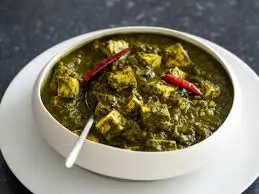In the world of Indian cuisine, two dishes often find themselves in the spotlight – Palak Paneer and Saag Paneer. These green, creamy, and utterly delicious vegetarian dishes have won the hearts of food enthusiasts worldwide. But what sets them apart? In this informative article, we’ll delve deep into the realms of Palak Paneer vs. Saag Paneer, exploring their ingredients, flavors, and origins, and providing you with step-by-step recipes to try at home.
Introduction
Indian cuisine is renowned for its diverse range of vegetarian dishes, and Palak Paneer and Saag Paneer are no exception. Both these dishes feature paneer, a popular Indian cheese, and a rich, green, leafy base. While they may seem similar at first glance, there are subtle differences that make each dish unique. So, whether you’re a culinary connoisseur or just someone looking to try something new, this guide will help you decide which dish to savor.
Palak Paneer: The Creamy Spinach Delight
The Ingredients
Palak Paneer, as the name suggests, is primarily made with spinach (palak) and paneer (Indian cottage cheese). Additional ingredients include tomatoes, onions, ginger, garlic, and a blend of aromatic spices. The spinach is blanched and pureed, creating a vibrant green gravy that forms the base of the dish.
Flavor Profile
The flavor of Palak Paneer is a harmonious blend of earthy spinach and the rich creaminess of paneer. The spices lend a subtle heat, while the tomatoes add a hint of tanginess. It’s a mild and comforting dish, perfect for those who prefer a less spicy option.
Origin
Palak Paneer originated in North India, particularly in the Punjabi region. It has since become a beloved classic, not just in India but across the globe.
Recipe: Homemade Palak Paneer
Here’s a simple recipe to make Palak Paneer at home:
Ingredients:
2 cups of fresh spinach leaves
200g paneer (cottage cheese)
1 onion, chopped
2 tomatoes, chopped
2 cloves of garlic
1-inch piece of ginger
1 tsp cumin seeds
1 tsp coriander powder
1/2 tsp turmeric powder
Salt and red chili powder to taste
2 tbsp cooking oil
2 tbsp fresh cream (optional)
Instructions:
Blanch the spinach leaves in boiling water for 2-3 minutes. Drain and transfer to a bowl of ice water to retain the vibrant green color. Blend the spinach, ginger, and garlic into a smooth paste.
Heat oil in a pan and add cumin seeds. Once they splutter, add chopped onions and sauté until golden brown.
Add chopped tomatoes and cook until they soften.
Stir in the spinach paste, coriander powder, turmeric powder, salt, and red chili powder. Cook for 5-7 minutes.
Add the paneer cubes and simmer for another 5 minutes.
Finish with fresh cream (if desired) and serve hot with naan or rice.
Saag Paneer: The Wholesome Greens
The Ingredients
Saag Paneer uses a mix of various green leafy vegetables, which can include mustard greens, fenugreek leaves, and collard greens. These greens are cooked with paneer, giving the dish its distinctive texture and flavor. Saag Paneer is also seasoned with spices like cumin, coriander, and turmeric.
Flavor Profile
Saag Paneer boasts a robust and slightly bitter flavor profile, thanks to the mix of greens. The spices add depth and warmth to the dish. It’s a flavorful option for those who enjoy a slightly spicier and more complex taste.
Origin
Originating in the Punjab region of India, Saag Paneer reflects the region’s agricultural abundance. It’s a dish that celebrates the hearty greens grown in this fertile land.
Recipe: Homemade Saag Paneer
Here’s a simple recipe to make Saag Paneer at home:
Ingredients:
2 cups of mixed greens (mustard greens, fenugreek leaves, collard greens, etc.)
200g paneer (cottage cheese)
1 onion, chopped
2 tomatoes, chopped
2 cloves of garlic
1-inch piece of ginger
1 tsp cumin seeds
1 tsp coriander powder
1/2 tsp turmeric powder
Salt and red chili powder to taste
2 tbsp cooking oil
2 tbsp butter
Instructions:
Blanch the mixed greens in boiling water for 2-3 minutes. Drain and transfer to a bowl of ice water to retain the vibrant green color. Blend the greens, ginger, and garlic into a smooth paste.
Heat oil and butter in a pan, add cumin seeds, and let them splutter. Add chopped onions and sauté until golden brown.
Add chopped tomatoes and cook until they soften.
Stir in the green paste, coriander powder, turmeric powder, salt, and red chili powder. Cook for 5-7 minutes.
Add the paneer cubes and simmer for another 5 minutes.
Serve hot with naan or Jeera rice.
Palak Paneer vs. Saag Paneer: Which One to Choose?
Both Palak Paneer and Saag Paneer offer a delightful experience for your taste buds, but the choice ultimately comes down to personal preference.
If you prefer a milder, creamier dish with a focus on spinach, Palak Paneer is the way to go. It’s a fantastic option for those who are new to Indian cuisine or prefer a less spicy meal.
On the other hand, if you’re looking for a dish with a more complex flavor profile, Saag Paneer is the winner. Its mix of greens and spices provides a bolder taste that appeals to those who enjoy a spicier palate.
FAQs
Q: Can I make these dishes at home?
A: Absolutely! Both Palak Paneer and Saag Paneer are easy to prepare at home using the provided recipes.
Q: Are Palak Paneer and Saag Paneer healthy?
A: Yes, both dishes are packed with nutrients from the greens and paneer. They are a good source of protein, vitamins, and minerals.
Q: Can I substitute paneer with tofu for a vegan version?
A: Yes, tofu is a popular vegan substitute for paneer in these dishes. It retains the creamy texture and absorbs the flavors well.
Q: Which dish is more popular in restaurants?
A: Palak Paneer tends to be more popular in Indian restaurants due to its milder flavor profile, making it a favorite among a wider audience.
Q: What’s the best way to enjoy these dishes?
A: Both dishes are best enjoyed with Indian bread like naan or roti. They also pair well with rice.
Q: Are there regional variations of these dishes?
A: Yes, different regions of India may have their own variations of Palak Paneer and Saag Paneer, incorporating local ingredients and spices.
Conclusion
In the Palak Paneer vs. Saag Paneer showdown, there’s no clear winner – it all boils down to your taste preferences. Whether you opt for the mild creaminess of Palak Paneer or the bold flavors of Saag Paneer, you’re in for a delightful culinary experience. So, the next time you’re at an Indian restaurant or planning to cook up some Indian cuisine at home, you’ll know exactly what to order or prepare. Enjoy your journey through the vibrant world of Indian flavors! flavors!
Disclaimer -In these simple recipes and cooking tips blog or website, the ingredients may or may not accept the specific body and cause allergy or side effects. Users are advised to be cautious and to make their own decisions in using the ingredients/recipes recommended. simplerecepieandcookingtips.com or its owners will not be responsible for any issues relating to the usage of the given recipes It should not be considered a substitute for a professional nutritionist’s advice.




